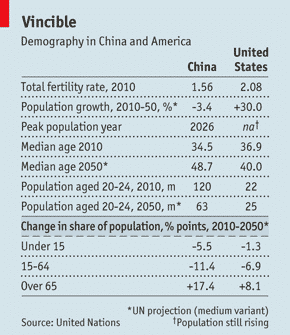Chart of the Day: Demography, China’s Achilles heel
This chart comes from the Economist where they write:
Over the past 30 years, China’s total fertility rate—the number of children a woman can expect to have during her lifetime—has fallen from 2.6, well above the rate needed to hold a population steady, to 1.56, well below that rate (see table). Because very low fertility can become self-reinforcing, with children of one-child families wanting only one child themselves, China now probably faces a long period of ultra-low fertility, regardless of what happens to its one-child policy.
The government has made small adjustments to the policy (notably by allowing an only child who is married to another only child to have more than one child) and may adapt it further. But for now it is firmly in place, and very low fertility rates still prevail, especially in the richest parts of the country. Shanghai reported fertility of just 0.6 in 2010—probably the lowest level anywhere in the world. According to the UN’s population division, the nationwide fertility rate will continue to decline, reaching 1.51 in 2015-20. In contrast, America’s fertility rate is 2.08 and rising.
Bottom line: The demographic trend in China will have profound economic and social consequences. China will grow old even before it becomes rich. What is that going to do to the so-called savings glut in China given the need for re-balancing away from an economy dependent on capital spending? Nothing good, I say.
Much more here:
Source: China’s Achilles heel – The Economist

I recall reading sometime back that China has a demographic emergency of sorts right now due sex specific abortions – lots of young men with nowhere to go – so to speak..
With a falling birth rate the savings glut will shrink very rapidly but that could be good. It will interest rates to rise globally and finally clear out the mal investment that is being kept afloat by QE and LTRO. Also a falling population reduces unemployment which is a significant threat to the stability of China. It raises productivity and eases pressure globally for resources. Continuous population growth in China will mean that they have to expand across their borders to meet water and food needs.
I don’t follow where the savings rate falls here. At present people are engaging in precautionary savings due to a proud social safety net. With an aging population is that going to get better or worse?
Also, every country that ages has found their grown rates shrinking and that means fewer new jobs. So it’s not clear to me this transition will happen the way you indicate.
From what I see happening here demographically, it means that fewer workers are there to support an aging population. That is an inherently deflationary phenomenon which means that consumer spending growth cannot grow enough to make China rich before the demographics kick in. We already see this happening in Germany, Italy and Japan. China is coming as well.
«fewer workers are there to support an aging population.»
Somewhere else I read that the dependency ratio also includes children, not just oldies, and that seems fair. Because under-18 and over-65 both usually don’t work but require sustenance, child care, and for children schooling.
So what matter is the percent of the population who are of working age; so what matters more than the percent of over 64 is the percent of the population in the middle, 15-64 in the above tables.
BTW I think that in 2050 probably the 18-65 or even the 20-70 percentage should be the more relevant, because a larger proportion of young Chinese will study for longer, and of older Chinese will retire later.
China is a densely populated country (at least in the fertile/non-desert areas).
If the Chinese government expects that between now and 2050 growth will be constrained by resources (from water to fertile land to energy) they are probably doing the right thing, as they are trying to target GNP per person, not just total GNP.
A country like the USA which is run by a propertarian elite instead aims at ever higher aggregate GNP, even if GNP per person were to go down, turning the USA in a clone of Texas or Brazil, with a growing number of poorer workers and ever richer property owners.
Demography is not necessarily destiny. The Chinese have a 10-point advantage in IQ, and an edge in energy and cooperation. The country is run by data-driven engineers who have an 85% – 90% approval and trust rating from their people.
I suspect that this article is nothing more than another of The Economist’s predictions that China is headed for a ‘hard landing’. The Economist has made 53 such predictions in the last 30 years. This one has a longer horizon but will probably be proven as hopelessly wrong as the rest.
The real question is: Why do I keep renewing my subscription to The Economist?
You’re way off base. The Economist has a wager with Michael Pettis about just this issue and it is Pettis who is taking the hard landing side. The Economist is on record for predicting a soft landing.